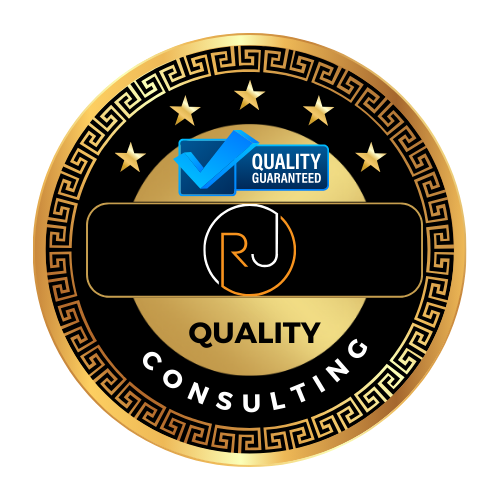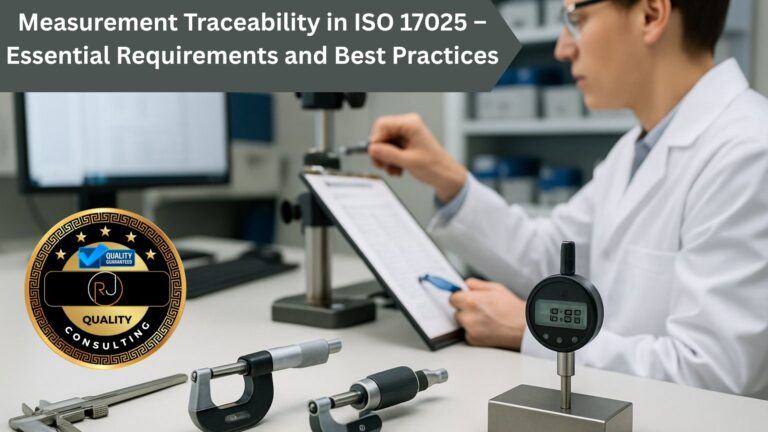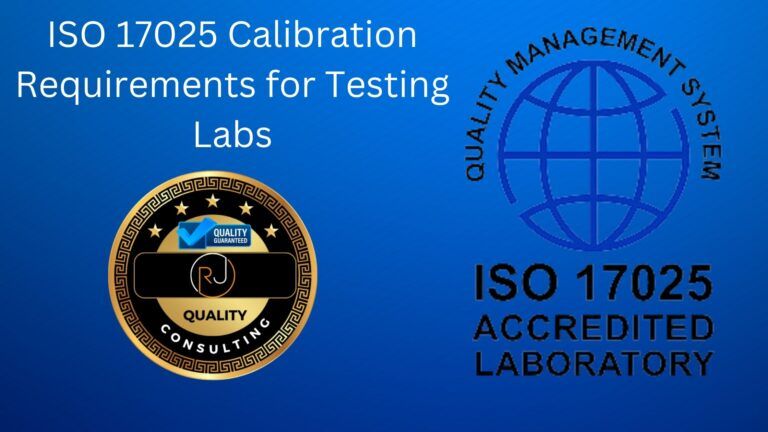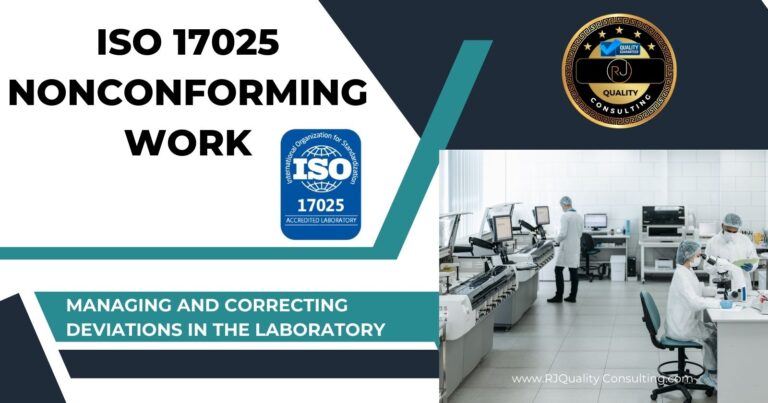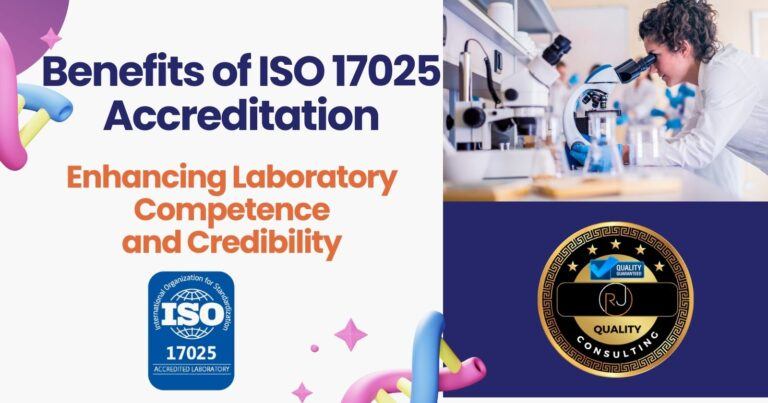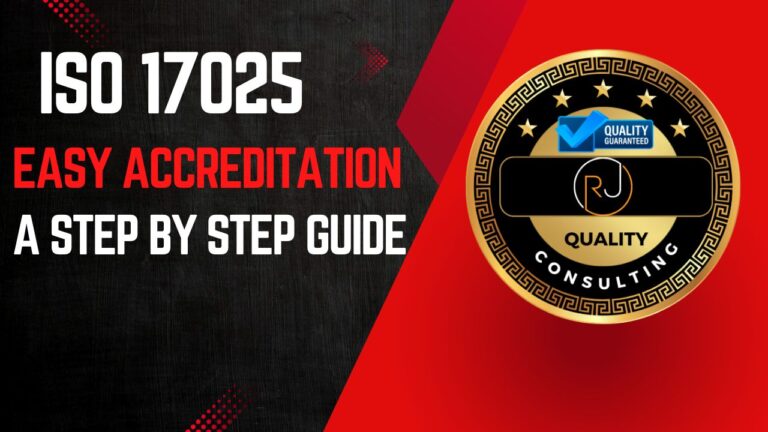How to Implement ISO 17025: Essential Steps for Laboratory Accreditation
As a certified ISO/IEC 17025 assessor with over 30 years of experience in Quality Management, I have guided numerous laboratories through successful implementations. Learning how to implement ISO 17025 within your laboratory requires a systematic approach, commitment from management, and a clear understanding of the standard’s requirements. The aim is to develop a quality management system that not only improves your laboratory’s operations but also fulfills the criteria for international recognition.
This post will guide and help you understand how to implement ISO 17025. The process involves careful planning, adherence to critical steps, and establishing documentation and procedures that align with the standard. By doing so, you ensure that your laboratory’s testing and calibration results are consistent, reliable, and accepted worldwide.

To successfully implement ISO/IEC 17025, you must familiarize yourself with the scope of the standard and tailor the quality management system to fit your laboratory’s specific needs. This includes understanding the standard’s structure, which details all necessary protocols and processes. Following this, the preparation phase for implementation is crucial, encompassing stakeholder engagement and ensuring all necessary resources are available. Throughout the implementation process, maintaining a commitment to quality and continuous improvement helps to embed the standard’s principles into your laboratory’s culture, aiding in achieving accreditation.
📘 ISO/IEC 17025 Quality Manual Template
Accelerate your lab’s accreditation process with our comprehensive Quality Manual Template, designed to align with ISO/IEC 17025:2017 standards.
- Fully editable and customizable to fit your laboratory’s needs.
- Includes all necessary procedures, forms, and policies.
- Structured to facilitate easy implementation and compliance.
- Developed by experts with extensive ISO/IEC 17025 experience.
Key Takeaways
- Implementing ISO/IEC 17025 enhances the reliability and international acceptance of laboratory results.
- It requires a well-organized quality management system, with comprehensive documentation and procedures.
- ISO 17025 Accreditation reinforces commitment to excellence and continuous improvement within the laboratory.
How to Implement ISO 17025 Video
Understanding How to Implement ISO 17025
In this section, you will grasp the essentials of ISO 17025:2017, an international standard critical for testing and calibration laboratories seeking accreditation. You will learn both what ISO 17025:2017 is and why accreditation matters for instilling trust and confidence in a laboratory’s capabilities.
Explanation of ISO 17025:2017
ISO/IEC 17025:2017 is the leading international standard for testing and calibration laboratories. It specifies the general requirements for the competence to carry out tests and calibrations, including sampling. In my experience as an assessor, I have observed that laboratories adhering to this standard not only enhance their technical capabilities but also gain a competitive edge in the industry and offer more value to their customers. Key elements include:
- Scope: It applies to all organizations conducting laboratory activities, regardless of their size.
- General Requirements: It includes provisions for impartiality, confidentiality, and consistent operations.
- Structural Requirements: Ensures the laboratory is adequately resourced, with clear responsibilities for management and staff.
- Resource Requirements: Outlines the necessary personnel expertise, equipment, and supportive environment.
- Process Requirements: Describes the activities to ensure valid results, including standard operating procedures and quality assurance of tests, including ISO 17025 method validation requirements.
- Management System Requirements: This section provides options for laboratories to adopt a management system ensuring consistent quality, ongoing improvements, and customer satisfaction through internal audits, corrective action and ISO 17025 management review.
Significance of Accreditation
Accreditation to ISO/IEC 17025:2017 demonstrates a laboratory’s technical competence and a robust quality management system. Achieving this accreditation helps foster trust and confidence among customers, regulatory authorities, and accreditation bodies. Here are the primary benefits of this accreditation:
- International Recognition: Accredited laboratories are globally acknowledged for their operational standards, facilitating cross-border acceptance of test results and measurement data.
- Quality Improvement: The standard’s comprehensive scope ensures systematic optimization of laboratory operations, enhancing the reliability of results.
- Regulatory Compliance: Laboratories meet international and national regulations, providing a competitive edge in the industry.
By meeting these requirements, your laboratory can not only achieve a high standard of technical proficiency but also gain a valuable mark of reliability in the global market.
Navigating the ISO/IEC 17025 Accreditation Process
Achieving ISO/IEC 17025 accreditation is a significant milestone that underscores a laboratory’s commitment to quality and technical competence. The accreditation process involves several critical steps:
- Application Submission: Initiate the process by submitting an application to the accreditation body, detailing your laboratory’s scope of activities.
- Contract and Quotation: Upon application review, the accreditation body provides a quotation. Agreeing to the terms formalizes the contract, setting the stage for the assessment process.
- Preparation for Accreditation: Develop and implement a robust quality management system (QMS) tailored to ISO/IEC 17025 standards. This phase includes staff training, documentation, and systematizing laboratory processes.
- Documentation Review: The accreditation body evaluates your QMS documentation to ensure compliance with ISO/IEC 17025 requirements.
- Internal Audit and Management Review: Conduct internal audits to identify gaps and perform management reviews to assess the effectiveness of the QMS.
- Submission of Proficiency Testing (PT) Plan and Results: Prepare a four-year PT plan and submit the results from the first year to demonstrate your laboratory’s competency.
- Accreditation Assessment: n on-site assessment is performed by the accreditation body to verify the implementation and effectiveness of your QMS and technical operations.
- Corrective Actions: Address any non-conformities identified during the assessment through well-documented corrective actions.
- Accreditation Decision: Upon satisfactory resolution of all findings, the accreditation body grants accreditation, recognizing your laboratory’s competence.
- Surveillance Assessments: Regular assessments are conducted to ensure ongoing compliance and continual improvement.
How Professional Support Can Facilitate Your Accreditation Journey
Navigating the complexities of ISO/IEC 17025 accreditation can be challenging.
As a certified ISO/IEC 17025 assessor, I offer tailored support to guide your laboratory through each phase of the accreditation process.
Depending on your laboratory’s current status, our approach can be customized as follows:
For Laboratories Without a Quality Manual and Procedures:
- Quality Manual and Procedure Development: Drafting comprehensive documentation aligned with ISO/IEC 17025 standards.
- Implementation Support: Assisting in the practical application of procedures and processes within your laboratory operations.
- Test Method Identification: Helping to select and validate appropriate test methods relevant to your scope of accreditation.
- Internal Audit and Gap Analysis: onducting thorough assessments to identify areas needing improvement.
- Corrective Action Guidance: roviding strategies to address identified gaps effectively.
- Proficiency Testing Plan Development: ormulating a structured four-year PT plan to monitor and demonstrate technical competence.
- Management Review Facilitation: eading management review meetings to evaluate QMS performance and identify opportunities for improvement.
- Accreditation Scheduling Assistance: oordinating with the accreditation body to schedule assessments and serving as a liaison during the process.
- On-Site Support During Assessment: eing present during the accreditation assessment to provide immediate assistance and clarification as needed.
For Laboratories with Existing Quality Documentation:
- Internal Audit and Gap Analysis: eviewing current documentation and practices to ensure alignment with ISO/IEC 17025 standards.
- Corrective Action Support: ssisting in implementing necessary changes to address any identified non-conformities.
- Proficiency Testing and Competency Evaluation: nsuring ongoing compliance with proficiency testing requirements and evaluating staff competency.
- Management Review and Accreditation Preparation: acilitating management reviews and final preparations for the accreditation assessment.
- Accreditation Scheduling and On-Site Assistance: Guiding you through the scheduling process and providing support during the assessment.
So, what do you need to do in order to get this help? Set up a Free 45- minute consultation with me and we will discuss an affordable pathway to reach your goals.
Preparation Steps on How to Implement ISO 17025

Prior to implementing ISO 17025, it is crucial to assess your current laboratory processes against the standard’s requirements and establish comprehensive documentation and policies. This may seem obvious, but it is imperative to obtain a copy of the ISO/IEC 17025:2017 standard and actually read it. If you are unwilling to do this, then I suggest not even attempting to get your laboratory ready for laboratory accreditation.
Audit and Gap Analysis for ISO 17025 Implementation
Audit your current systems to identify the gaps between your existing processes and the requirements of ISO 17025. This will highlight areas that need improvement and help you prioritize your actions.
- Risks: Look for any non-conformities that could pose a risk to quality and compliance.
- Opportunities: Seek out areas where improvements can create efficiencies or enhance quality.
A structured approach to this step would typically involve the following:
- Review of Current Procedures: Examine your current laboratory procedures to gauge their alignment with ISO 17025 standards.
- Identification of Gaps: Clearly outline where current practices fall short of the standard’s expectations.
- Planning for Improvement: Develop a plan to address these gaps, focusing on both process enhancement and risk mitigation.
Developing Documentation and Policies
Establishing and revising your documentation and policies is vital for successful ISO 17025 implementation. Documentation should reflect all processes and procedures necessary for achieving and maintaining compliance. For instance, in a recent project with one of my laboratory clients, we developed a comprehensive quality manual that included the same clause elements of the standard and pointed to the associated procedure. This activity alone streamlined their operations and facilitated a smoother accreditation process. It also helped them with their internal audit process.
- Documentation: Create a master list of all documents you need, including manuals, protocols, and records.
- Procedures: Develop formalized procedures that are clear, accessible, and consistently applied within your laboratory environment.
- Align your quality manual: to the same clause structure as the standard.
- Use My Free Internal Audit Checklist: Note the gap analysis instructions. This will help you understand your own QMS.
For an organized documentation system, consider the following steps:
- Policy Manual: Draft a policy manual that embodies the mission and quality objectives of your laboratory.
- Standard Operating Procedures (SOPs): Write detailed SOPs for all technical and quality-related processes.
- Control of Documents: Implement controls to manage document creation, revision, and distribution to ensure they are current and available where needed.
Utilizing Templates for ISO 17025 Implementation
Incorporating well-structured templates into your ISO 17025 implementation process can significantly streamline the journey towards accreditation. Templates offer a consistent framework for managing documentation, ensuring that your laboratory adheres to the standard’s stringent requirements without missing critical elements. Below are some ways templates can support your laboratory in complying with ISO 17025.
1. Document Control Templates
Managing documents effectively is crucial under ISO 17025. Templates for document control allow you to track revisions, approvals, and distribution, ensuring that all documentation remains up-to-date and accessible. These templates typically include fields for version history, responsible personnel, and approval signatures, providing a comprehensive record for audits.
2. Quality Manual and Procedure Templates
Creating a comprehensive Quality Manual and detailed procedures is an essential part of ISO 17025 compliance. Using templates can save time and provide consistency across all your laboratory’s documentation. Templates often come pre-formatted with headings and sections based on ISO 17025 requirements, ensuring you don’t overlook any key components.
For instance, you can use a standard operating procedure (SOP) template to ensure uniformity across various tasks, from calibration to testing. This ensures that all procedures are clear, repeatable, and meet the standard’s expectations.
3. Risk and Opportunity Assessment Templates
ISO 17025 requires laboratories to identify risks and opportunities within their operations. Utilizing risk assessment templates provides a systematic way to document potential risks, categorize their impact, and track mitigative actions. Templates also help ensure that you regularly review and update these assessments as part of your continuous improvement efforts.
4. Training and Competence Records Templates
Tracking staff training and competency is essential for ISO 17025 compliance. Templates for training records make it easy to document the skills, qualifications, and ongoing development of your team. By using a standardized format, you ensure that all personnel have the necessary training to perform their tasks, and you can easily present these records during audits.
5. Internal Audit and Management Review Templates
Internal audits and management reviews are core requirements for maintaining ISO 17025 accreditation. Templates for internal audits can guide your team through the process, ensuring all areas of the standard are reviewed and non-conformities are identified. Similarly, management review templates can provide a structured agenda and checklist, helping management evaluate the laboratory’s performance and make informed decisions for continuous improvement.
Utilizing ISO 17025 templates not only simplifies the implementation process but also provides a reliable way to manage and control critical documents and procedures. Templates help ensure consistency, facilitate compliance, and save valuable time, making them an indispensable tool for laboratories aiming to achieve and maintain ISO 17025 accreditation.
This template includes everything you need to manage your documentation effectively, from version tracking to approvals, helping your lab stay compliant and ready for accreditation audits. Don’t miss out on this invaluable resource to streamline your journey towards ISO 17025 accreditation!
Key ISO 17025 Documentation and Procedures Required for ISO 17025 Implementation

Implementing ISO 17025 effectively hinges on developing, maintaining, and controlling critical documents and procedures that assure quality, standard compliance, and evidence of competence. These foundational elements form the backbone of your laboratory’s management system and help you really understand how to implement ISO 17025 in a laboratory.
Document and Record Control Procedure
Your Document and Record Control Procedure is crucial to maintain the integrity of your management system. It ensures that documents — from test methods to calibration results — are approved, reviewed, and updated by authorized personnel. Controlled documents must include:
- A master list or a registry of all essential documents
- A defined process for document creation, approval, revisions, and distribution
- A method for identifying changes and the current revision status of documents
Quality Policy and Objectives
Developing a clear Quality Policy demonstrates your commitment to quality and compliance with ISO 17025 and how to implement ISO 17025 in a laboratory effectively. Your policy should:
- Align with the overarching goals of ISO 9001 where applicable
- Reflect your lab’s dedication to producing reliable and accurate test/calibration results
- Be communicated and understood within the organization
Additionally, your lab must establish Quality Objectives that are measurable and relevant to the intent of the quality policy, which contribute to the enhancement of the lab’s overall performance.
Competence, Training, and Awareness Procedure
Competence, Training, and Awareness Procedures establish a framework to ensure that all personnel handling complex technical tasks are appropriately qualified. This encompasses:
- Identification of competency needs in accordance with the testing and calibration activities
- Ensuring that all personnel undergo regular training to meet these requirements
- Maintaining records of training, skills, experience, and qualifications for all staff
Regular evaluations are necessary to affirm that the team possesses the necessary competence and that all training is up to date, thus supporting the consistent application of standards and quality outputs and the overall understanding on how to implement ISO 17025 in a laboratory effectively.
Implementing Quality Management System

To effectively implement an ISO 17025 Quality Management System, you must focus on personnel capability, adequate infrastructure, and established procedures for external products and services. Drawing from my experience, investing in regular staff training and upgrading laboratory equipment significantly contributes to maintaining high-quality standards and achieving accreditation.
Training and Awareness
Your success in implementing a Quality Management System hinges on a well-trained team. Firstly, identify the competencies required for various roles within your laboratory. Secondly, develop a training plan that covers:
- ISO 17025 requirements
- Laboratory procedures
- Quality control measures
- Data analysis and reporting
Ensure that each team member receives training pertinent to their duties. Keep records of all training activities to demonstrate compliance and maintain a culture of continuous learning and awareness.
Equipment and Facility Adequacy
Assess and maintain the suitability of your laboratory’s equipment and facilities to fulfill testing and calibration tasks. This entails:
- Regular calibration and maintenance of equipment
- Environmental conditions controlled to meet the required specifications
- Adequacy of space for preventing contamination and ensuring safety
Establish and adhere to equipment operating procedures and document any deviations or issues that arise, including corrective actions taken.
External Products and Services Procedures
When incorporating external products and services, your procedures should ensure they meet the necessary quality standards. This process includes:
- Selection of vendors based on criteria aligned with ISO 17025 standards.
- Evaluation and re-evaluation of suppliers for consistency in quality.
- Documentation of all specifications and performance requirements for externally provided products and services.
Continuous Improvement and Accreditation Process

In implementing ISO 17025, your laboratory’s commitment to continuous improvement is pivotal for maintaining accreditation and meeting both customer and regulatory requirements. This process employs methods such as internal audits and management review to identify areas for enhancement, ensuring you address risks and record findings to meet process requirements effectively.
Internal Audits and Management Review
Internal audits serve as a comprehensive check on your laboratory’s adherence to ISO 17025 standards. By regularly performing these audits, you:
- Assess the effectiveness of the implemented quality management system (QMS).
- Identify any potential risks and opportunities for improvement.
- Ensure impartiality in testing and calibration activities.
- Evaluate compliance with regulatory authorities and accreditation bodies.
Maintain detailed records of audit findings and use these to inform your management review. This review is a strategic meeting where top management critically assesses the QMS’s performance against the set objectives, discussing audit results, client feedback, and cooperation within the laboratory.
Accreditation Application Process
When you are ready to apply for accreditation, your thorough preparation will pay off. The accreditation application process includes:
- Compiling an application dossier for the selected accreditation body.
- Providing evidence that your lab meets process requirements.
- Demonstrating your ability to operate impartially and in the interest of your clients.
Successful accreditation confirms your laboratory’s technical competence and reliability to customers, regulatory authorities, and industry peers. Foster a strong relationship with the chosen accreditation body, as this cooperation is essential for the ongoing improvement and recognition of your laboratory’s competencies.
Benefits of Implementing ISO 17025:2017

When you implement ISO 17025:2017 in your laboratory, you harness several key benefits that enhance your operations and services. Here’s an overview highlighting the advantages:
Credibility and Trust: By adhering to ISO 17025:2017 standards, your laboratory’s credibility enhances significantly. Clients, regulatory authorities, and accreditation bodies see your commitment to quality, which builds trust in your services.
Reliable Results and Accuracy:
- Consistency: Your operation procedures are standardized, leading to more consistent and dependable outcomes.
- Measurement Accuracy: Handling of calibration and testing is improved, minimizing errors and enhancing the accuracy of results.
Wider Acceptance: The international recognition of ISO 17025:2017 means that your laboratory’s test results gain wider acceptance across different countries and industries, easing the path to global business.
Increased Confidence:
- Internal: Your workforce gains clarity on their roles, increasing confidence in carrying out their responsibilities.
- External: Customers and stakeholders can have confidence in your reliable and accurate measurement and calibration services, knowing they are conducted according to a globally recognized standard.
Conclusion

To successfully implement ISO 17025, your approach must be systematic and well-planned. Allocate quality time and resources to each step of the process, ensuring that every action is aligned with the standard’s requirements. If you have specific questions or need personalized guidance, feel free to reach out to me through the contact information provided below.
Begin with a thorough gap analysis to determine your laboratory’s current standing relative to the ISO 17025 criteria. This will guide you in developing a precise action plan.
Below is a summary to reinforce the key aspects of ISO 17025 implementation and how to implement ISO 17025 in a laboratory:
- Management Support: Your implementation’s foundation relies on unwavering support from management.
- Resources: Appropriate resources, both human and material, are vital for the execution of your plan.
- Systematic Approach: Implement procedures methodically, proceeding with clarity and purpose.
- Quality: Quality must be the central focus throughout the implementation, influencing all decisions.
- Review: Conduct regular reviews to assess progress and make necessary adjustments.
Frequently Asked Questions

The FAQs provide a structured roadmap to understanding the intricacies of ISO 17025 implementation and gaining accreditation.
What steps are involved in developing an ISO 17025 implementation project plan?
To develop an ISO 17025 project plan, you must first outline the strategic objectives, define responsibilities, set timelines, and allocate resources. Assess your laboratory’s current operations against ISO 17025 requirements to identify areas for improvement.
What are the essential requirements for achieving ISO 17025 accreditation in a laboratory?
Achieving ISO 17025 accreditation requires your laboratory to consistently produce valid and reliable results. Your lab must demonstrate technical competence, a sound quality management system, and the ability to fulfill the standard’s methodological, reporting, and calibration requirements.
How can a gap analysis help with ISO 17025 accreditation?
Conducting a gap analysis is crucial as it helps you pinpoint the differences between your laboratory’s current practices and the ISO 17025 standards. This analysis will provide the insights needed to create an effective action plan to address those gaps.
What procedures must be established to comply with ISO 17025 standards?
You must establish procedures for all laboratory activities that impact the quality of your testing and calibration outcomes. This includes procedures for handling test items, ensuring the quality of results, and corrective actions for non-conformance.
What documentation is necessary for ISO 17025 accreditation?
ISO 17025 certification requires you to have comprehensive documentation, including a quality manual, policies, procedures, and records that demonstrate your laboratory’s adherence to the standard’s criteria and processes. If you are looking for a specific detailed list of the required documents for ISO 17025 accreditation go here.
How should staff be trained to ensure compliance with ISO 17025?
Staff training for ISO 17025 compliance should cover the standard’s requirements, their specific responsibilities, the operation of pertinent equipment and technologies, and the management of documents and records to ensure ongoing adherence to procedures.
🕒 Book Your Free 45-Minute Consultation
Have questions about ISO/IEC 17025 or ISO 9001 implementation or accreditation? Schedule a free 45-minute consultation with me to discuss your Company or laboratory’s needs and how we can achieve compliance together.
Schedule Your Consultation